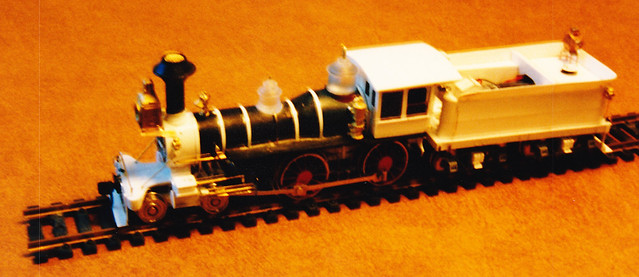For this I blame Hal Kinsey. I could blame Raoul Marten, but I never met him, and so, Hal gets the blame.
It must have been 1993, and I was working on my first Canada Atlantic locomotive, 607. I started with a Bachmann 4-4-0, with its awful tender drive, and found that with some changes in detail, it could pass for 607.
The engine truck needed to change, and so, I stopped in at Hal Kinsey’s shop, Central Hobbies, which is still the best hobby shop in the Pacific Northwest. What makes Central good, is the vast stock teetering in piles and off pegs, waiting to be discovered on either side of cramped aisles.
On this day in 1993, it didn’t disappoint: I found 26″ wheels not only the regular code 110 but in code 72 as well. I bought the code 72 because they didn’t look silly.
This was something I had never thought about before – that even the best of our models might be flawed in something so basic as their wheels. It set me to wondering, what is the right width for a wheel in HO scale?
By the time I had 607 ready for paint, I had decided that it would probably be easier and more satisfying to scratch build the next locomotive, but I was in for a penny in for a pound, and pressed forward to completion.
1993 was also around the time when the new acrylic paints started coming out, and I decided I would try them on my new model. That was a huge mistake. The paint came out like an orange peel, and through the remediation process, the model fell apart in my hands. I took this setback as a sign that I should abandon 607 altogether.
The next year, 1994, I attended my first NMRA national convention, in Portland. There, Jim Harper presented a clinic on scale track that took everyone’s breath away. “Please, tell us that’s not a model,” someone cried from the audience.
“Could you achieve these results in HO scale?” someone else asked. “No” was the general consensus, but a few of us in the room that day were willing to give it a try. So, I, being still young and foolish, stuck up my hand and volunteered to start a SIG, and the Proto:87 SIG was born (if you want to know about P87, go there).
Now, it turns out that running a SIG, even a small one like Proto:87, which never had more than a few dozen members, is a lot of work. In the end, I felt that the hard copy newsletter should be eclipsed by the newsgroup when Yahoo Groups came along.
I could better promote Proto:87 by getting successful with it and publishing my results. So, that’s what I’ve been doing. Maybe I should have stuck with editing the newsletter.
